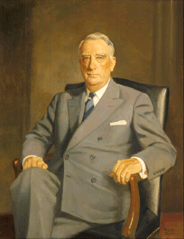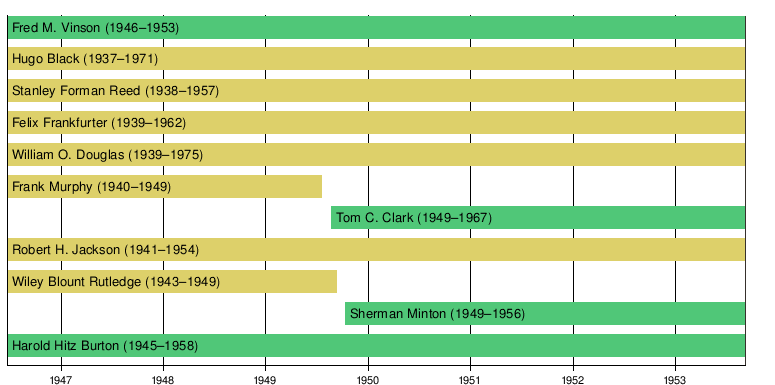Vinson Court
The Vinson Court refers to the Supreme Court of the United States from 1946 to 1953, when Fred Vinson served as Chief Justice of the United States. Vinson succeeded Harlan F. Stone as Chief Justice after the latter's death, and Vinson served as Chief Justice until his death, at which point Earl Warren was nominated and confirmed to succeed Vinson.
| Vinson Court | |
|---|---|
 Chief Justice Fred Vinson | |
| June 24, 1946 – September 8, 1953 (7 years, 76 days) | |
| Seat | Supreme Court Building Washington, D.C. |
| No. of positions | 9 |
| Vinson Court decisions | |
 | |
The court presided over the country during the start of the Cold War and the Korean War. The court's decisions reflected the continuing ideological battle between the judicial restraint of Justice Felix Frankfurter and the civil rights activism of Justices William O. Douglas and Hugo Black. Frankfurter's more conservative views prevailed during the Vinson Court, but many of the dissents written during the Vinson Court would lay the groundwork for the major rulings during the succeeding Warren Court.
Membership
The Vinson Court began in 1946, when Secretary of the Treasury Fred Vinson was confirmed to replace Harlan Stone as Chief Justice. Vinson was appointed by President Harry Truman, who had also appointed Harold Hitz Burton to the court in 1945.
At the beginning of the Vinson Court, the court consisted of Vinson, Burton, and seven Roosevelt appointees: Hugo Black, Stanley F. Reed, Felix Frankfurter, William O. Douglas, Frank Murphy, Robert H. Jackson, and Wiley Blount Rutledge. Rutledge and Murphy both died in 1949, prompting Truman to appoint Tom C. Clark and Sherman Minton to the bench.
Vinson died in September, 1953. President Dwight Eisenhower appointed Earl Warren as Vinson's successor by means of a recess appointment.
Timeline
Rulings of the Court
The short tenure of the Vinson Court gave it relatively little time to render major rulings, but decisions of the court include:[1]
- Everson v. Board of Education (1947): In a 5-4 decision written by Justice Black, the court upheld a New Jersey law that provided for transportation reimbursement for children attending private schools. The court unanimously incorporated the Establishment Clause via the Fourteenth Amendment, but the majority held that the New Jersey law did not violate the Establishment Clause because the reimbursements were provided to all parents regardless of religion.
- Shelley v. Kraemer (1948): In a 6-0 decision written by Justice Vinson, the court struck down a racially restrictive covenant which had prevented people of color from purchasing a house in St. Louis, Missouri. The court held that such covenants cannot be enforced by courts of law since doing so would violate the Equal Protection Clause.
- McCollum v. Board of Education (1948): In an 8-1 decision written by Justice Black, the court struck down an Illinois program that used public school classrooms to teach voluntary religion classes during school hours. The court held that the classes violated the Establishment Clause.
- United States v. Paramount Pictures, Inc. (1948): In a 7-1 opinion written by Justice Douglas, the court forced the Big Eight film studios to sell their movie theaters in order to comply with the Sherman Antitrust Act. The decision curtailed the vertical integration of the film studios, as well as the practice of block booking.
- Dennis v. United States (1951): In a plurality decision written by Justice Vinson, the court upheld the conviction of Eugene Dennis, a Communist Party leader, under the Smith Act. The court held that the First Amendment does not protect activities that seek to overthrow the United States government. Brandenburg v. Ohio (1969) largely overruled this holding.
- Joseph Burstyn, Inc. v. Wilson (1952): In a 9-0 decision written by Justice Clark, the court ruled that motion pictures qualify as art and thus receive some protections from the First Amendment in the face of government censorship. The decision overturned Mutual Film Corp. v. Industrial Commission of Ohio (1915). Later cases expanded on Burstyn to the point that the government can only censor films for obscenity.[2]
- Youngstown Sheet & Tube Co. v. Sawyer (1952): In a 6-3 decision written by Justice Black and in which five justices wrote concurrences, the court ordered President Truman to return control of several steel mills to their owners. Truman had taken control of the mills after the 1952 steel strike, which presented a threat to the American effort in the Korean War. The large number of concurrences made the precedential value of the ruling unclear, but the ruling nonetheless checked the executive power of the president. Justice Jackson's concurring opinion laid out three categories of executive power and made a lasting impact in the understanding of separation of powers.[3]
- United States v. Reynolds (1953): In a 6-3 decision written by Justice Vinson, the court recognized the state secrets privilege. The decision allowed the government to avoid releasing papers regarding the 1948 Waycross B-29 crash.
Judicial philosophy
Vinson took office at a time when the court was divided into two camps: a progressive camp led by Justices Black and Douglas, and a more conservative camp led by Justices Jackson and Frankfurter.[4] President Roosevelt had appointed justices who would uphold the more expansive economic regulations of the New Deal (thus ending the Lochner era), but the same Roosevelt appointees often split on civil liberties cases.[5] The Truman appointees, who had executive or legislative branch experience and were reluctant to strike down government powers at the dawn of the Cold War, largely took the side of Jackson and Frankfurter.[4] Justices Rutledge and Murphy were part of the more liberal bloc prior to their death, while Burton and Reed tended to side with Frankfurter and Jackson.[6] The court thus took a more conservative position than the Stone Court (particularly after 1949),[6] which often struck down laws for conflicting with civil liberties.[5] However, the views of Black and Douglas generally won out in the succeeding Warren Court, and their dissents in Vinson Court cases such as Dennis helped lay the foundation for many of the Warren Court holdings.[7] On his death, The New York Times credited Vinson for soothing the tensions between the two blocs of justices,[8] but legal historian Michal Belknap argues that Vinson was largely unsuccessful in this endeavor.[4]
References
- Belknap, Michal (2004). The Vinson Court: Justices, Rulings, and Legacy. ABC-CLIO. pp. 89–91. Retrieved 3 March 2016.
- Wittern-Keller, Laura (11 January 2008). Freedom of the Screen: Legal Challenges to State Film Censorship, 1915-1981. University Press of Kentucky. p. 276. Retrieved 3 March 2016.
- Liptak, Adam (10 January 2006). "Focus of Hearings Quickly Turns to Limits of Presidential Power". New York Times. Retrieved 3 March 2016.
- Belknap, 162-163
- Belknap, 3-4
- Galloway, Jr., Russell (1 January 1982). "The Vinson Court: Polarization (1946-1949) and Conservative Dominance (1949-1953)". Santa Clara Law Review. 22 (2): 377, 388. Retrieved 4 March 2016.
- Belknap, 90, 165-167
- "Vinson Excelled In Federal Posts". New York Times. 9 September 1953. Retrieved 3 March 2016.
Further reading
Works centering on the Vinson Court
- Belknap, Michael R. (2004). The Vinson Court: Justices, Rulings, and Legacy. ABC-CLIO. ISBN 9781576072011.
- Palmer, Jan S. (1990). The Vinson Court Era: The Supreme Court's Conference Votes: Data and Analysis. AMS Press. ISBN 9780404616090.
- Urofsky, Melvin I. (1997). Division and Discord: The Supreme Court Under Stone and Vinson, 1941-1953. University of South Carolina Press. ISBN 9781570031205.
Works centering on Vinson Court justices
- Fassett, John D. (1994). New Deal Justice: the Life of Stanley Reed of Kentucky. Vantage Press. ISBN 9780533107070.
- Feldman, Noah (2010). Scorpions: The Battles and Triumphs of FDR's Great Supreme Court Justices. Grand Central Publishing. ISBN 9780446580571.
- Ferren, John M. (2006). Salt of the Earth, Conscience of the Court: The Story of Justice Wiley Rutledge. University of North Carolina Press. ISBN 9780807876619.
- Gronlund, Mimi Clark (2010). Supreme Court Justice Tom C. Clark: A Life of Service. University of Texas Press. ISBN 978-0292719910.
- Gugin, Linda C. (1997). Sherman Minton: New Deal Senator, Cold War Justice. Indiana Historical Society. ISBN 9780871951168.
- Howard, J. Woodford (2015) [1968]. Mr. Justice Murphy: A Political Biography. Princeton University Press. ISBN 9781400875641.
- Murphy, Bruce Allen (2003). Wild Bill: The Legend and Life of William O. Douglas. Random House. ISBN 9780394576282.
- Newman, Roger K. (1994). Hugo Black: A Biography. Pantheon. ISBN 978-0679431800.
- St. Clair, James E.; Gugin, Linda C. (2015). Chief Justice Fred M. Vinson of Kentucky: A Political Biography. University Press of Kentucky. ISBN 9780813158860.
- Urofsky, Melvin I. (1991). Felix Frankfurter: Judicial Restraint and Individual Liberties. Twayne. ISBN 9780805777741.
Other relevant works
- Abraham, Henry Julian (2008). Justices, Presidents, and Senators: A History of the U.S. Supreme Court Appointments from Washington to Bush II. Rowman & Littlefield. ISBN 9780742558953.
- Cushman, Clare (2001). The Supreme Court Justices: Illustrated Biographies, 1789–1995 (2nd ed.). (Supreme Court Historical Society, Congressional Quarterly Books). ISBN 1-56802-126-7.
- Friedman, Leon; Israel, Fred L., eds. (1995). The Justices of the United States Supreme Court: Their Lives and Major Opinions. Chelsea House Publishers. ISBN 0-7910-1377-4.
- Hall, Kermit L.; Ely, Jr., James W.; Grossman, Joel B., eds. (2005). The Oxford Companion to the Supreme Court of the United States (2nd ed.). Oxford University Press. ISBN 9780195176612.
- Hall, Kermit L.; Ely, Jr., James W., eds. (2009). The Oxford Guide to United States Supreme Court Decisions (2nd ed.). Oxford University Press. ISBN 978-0195379396.
- Hall, Timothy L. (2001). Supreme Court Justices: A Biographical Dictionary. Infobase Publishing. ISBN 9781438108179.
- Hoffer, Peter Charles; Hoffer, WilliamJames Hull; Hull, N. E. H. (2018). The Supreme Court: An Essential History (2nd ed.). University Press of Kansas. ISBN 978-0-7006-2681-6.
- Howard, John R. (1999). The Shifting Wind: The Supreme Court and Civil Rights from Reconstruction to Brown. SUNY Press. ISBN 9780791440896.
- Irons, Peter (2006). A People's History of the Supreme Court: The Men and Women Whose Cases and Decisions Have Shaped Our Constitution (Revised ed.). Penguin. ISBN 9781101503133.
- Martin, Fenton S.; Goehlert, Robert U. (1990). The U.S. Supreme Court: A Bibliography. Congressional Quarterly Books. ISBN 0-87187-554-3.
- Patterson, James (1996). Grand Expectations: The United States 1945–1974. Oxford University Press. ISBN 978-0195117974.
- Schwarz, Bernard (1995). A History of the Supreme Court. Oxford University Press. ISBN 9780195093872.
- Tomlins, Christopher, ed. (2005). The United States Supreme Court: The Pursuit of Justice. Houghton Mifflin Harcourt. ISBN 978-0618329694.
- Urofsky, Melvin I. (1994). The Supreme Court Justices: A Biographical Dictionary. Garland Publishing. ISBN 0-8153-1176-1.
